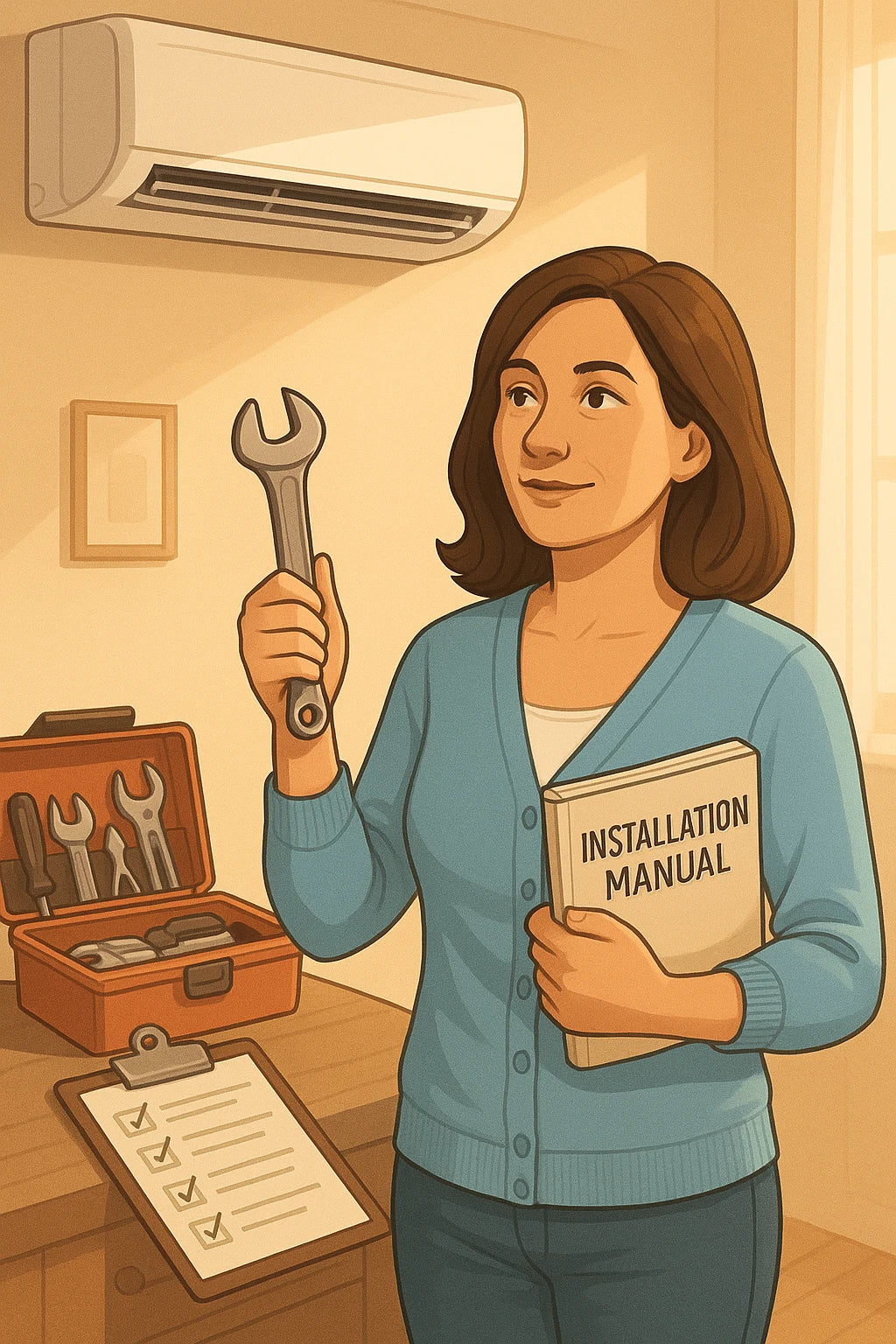🏡 Why Samantha Is Considering DIY Installation
Ductless mini-splits are known for their efficiency, comfort, and flexible installation options, leading many homeowners like Samantha to wonder:
Can I save money by installing a ductless mini-split system myself?
While DIY mini-split installation is possible with certain systems, there are risks, legal considerations, and potential hidden costs that Samantha should understand before deciding.
🔍 What Is Involved in Installing a Ductless Mini-Split?
A standard installation includes: ✅ Mounting the indoor air handler. ✅ Mounting the outdoor condenser. ✅ Drilling a 3-inch hole for the refrigerant line, drain, and electrical wiring. ✅ Running and securing line sets. ✅ Installing a condensate drain. ✅ Connecting electrical wiring. ✅ Evacuating and charging the refrigerant lines. ✅ Testing the system for leaks and proper function.
Learn about typical mini-split installation here.
🧰 Tools and Equipment Needed for DIY Installation
✅ Drill with hole saw (3-inch bit) ✅ Level and measuring tape ✅ Wrench and screwdrivers ✅ Vacuum pump and gauge manifold set ✅ Flaring tool (if required) ✅ Electrical wiring tools ✅ Torque wrench for refrigerant connections ✅ Safety gear (gloves, safety glasses)
Without a vacuum pump and gauges, a complete and safe installation is not possible.
⚠️ Refrigerant Handling Laws and Certification
Under EPA Section 608, handling refrigerants requires certification. ✅ Most mini-splits are shipped with refrigerant in the outdoor unit, but refrigerant lines must be vacuumed and tested. ✅ Some DIY kits come with pre-charged lines (Pioneer, MrCool) allowing homeowners to install without handling refrigerant directly. ✅ DIY installs on non-pre-charged systems can be illegal and unsafe if refrigerant is handled without certification.
Read more about EPA refrigerant handling requirements here.
✅ Pros of DIY Mini-Split Installation
✅ Save on labor costs ($1,000 - $3,000 potential savings). ✅ Flexible timeline for your project. ✅ Hands-on satisfaction for DIY enthusiasts. ✅ Good learning experience for future maintenance.
🚩 Cons and Risks of DIY Mini-Split Installation
🚨 Potential to void manufacturer warranties. 🚨 Improper installation can reduce system efficiency. 🚨 Risk of refrigerant leaks, which are costly and environmentally harmful. 🚨 Electrical hazards if wiring is not done to code. 🚨 Local permit and code compliance issues. 🚨 Possible need for professional correction, adding costs.
Read about the risks of DIY HVAC work here.
💰 Cost Comparison: DIY vs. Professional Installation
| Aspect | DIY | Professional |
|---|---|---|
| Equipment | $1,500 - $5,000 | $1,500 - $5,000 |
| Labor | $0 | $1,500 - $3,500 |
| Tools & Materials | $300 - $800 | Included |
| Warranty Risk | Higher | Lower |
| Total Estimated | $1,800 - $5,800 | $3,000 - $8,500 |
While DIY may save upfront, hidden costs, efficiency losses, or warranty issues can reduce those savings.
🛡️ Warranty Implications
✅ Many manufacturers require installation by a licensed HVAC professional for warranty validity. ✅ DIY installation can void coverage for parts and compressors. ✅ Using pre-charged DIY kits (MrCool, Pioneer) may retain warranties if installed per instructions.
Samantha should confirm warranty conditions before choosing DIY.
🧩 When DIY May Be a Good Fit for Samantha
✅ If using pre-charged DIY-friendly kits. ✅ If Samantha has advanced DIY skills and electrical knowledge. ✅ If local codes do not prohibit homeowner HVAC installations. ✅ For single-zone installs in easily accessible areas.
🚫 When It’s Best to Hire a Professional
✅ Multi-zone installations. ✅ If refrigerant charging or line modification is needed. ✅ In areas requiring permits and licensed installs. ✅ If Samantha wants full warranty protection. ✅ If unfamiliar with electrical safety and HVAC system pressures.
Learn when to hire a professional for HVAC work here.
📋 Samantha’s DIY Readiness Checklist
✅ Have I reviewed my system’s warranty terms? ✅ Is the mini-split system a pre-charged DIY-friendly kit? ✅ Do I understand electrical safety and local codes? ✅ Do I have or can I rent required tools (vacuum pump, gauges, etc.)? ✅ Am I comfortable drilling and sealing large wall penetrations? ✅ Am I prepared to handle unexpected challenges?
If "No" to any, hiring a professional may be safer and more cost-effective.
🌿 Environmental Considerations
✅ Improper refrigerant handling releases greenhouse gases. ✅ Professionals ensure refrigerant is handled and disposed of legally. ✅ DIY may be sustainable with pre-charged kits if done correctly.
✅ Conclusion: Should Samantha DIY Her Mini-Split Installation?
Samantha should consider DIY if: ✅ She uses a pre-charged DIY kit. ✅ She has the necessary skills, tools, and time. ✅ She understands and is comfortable with local code compliance.
Otherwise, hiring a professional is often worth the investment for: ✅ Peace of mind. ✅ Warranty protection. ✅ System efficiency and safety. ✅ Long-term comfort.
📲 Ready to Find the Right System?
Explore DIY and Professional Ductless Mini-Splits at The Furnace Outlet to find the perfect system for your comfort, skill level, and budget.
In the next topic we will read more about: Mitsubishi vs. Daikin vs. Gree: Which Ductless Mini-Split Brand Should You Choose?







